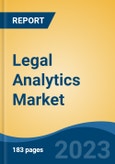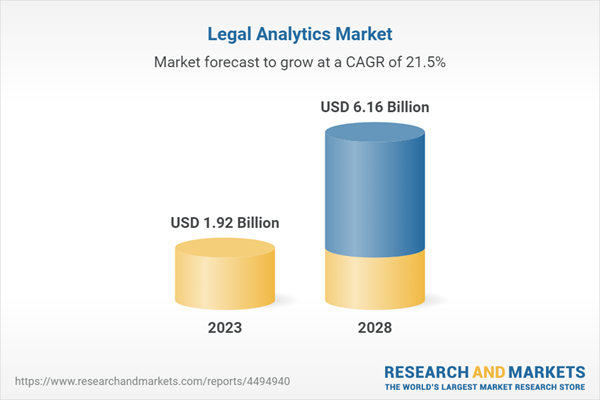Free Webex Call
The Global legal analytics market is predicted to proliferate during the forecast period due to the increasing adoption of cloud-based legal analytics solutions, especially in developing countries by enterprises to streamline collaboration, scalability, improve legal software integration along with the development of more enhancement in legal management. Legal analytics can help organisations identify trends and patterns that pinpoint when and where business growth occurs. By understanding these patterns, organizations can make better decisions about how to scale the financial potential, reduce costs and gain more clients. It gives businesses the opportunity to undiscover opportunities and strengthen its growth potential, increase efficiency, manage data spread across several sites while enhancing performance, dependability, and scalability. Additionally, increasing adoption of artificial intelligence (AI) and machine learning (ML) in legal analytics are increasing the demand of global legal analytics market. To compensate for the losses in complexity systems, businesses are increasingly utilising legal analytics services to offer more productive and take data-driven decisions and increasing legal capability for the legal professionals. Numerous innovations and product launch carried out in analytics are expected to enhance the features of legal analytics. Furthermore, the need for organizations to make Data-driven Decision Making (DDDM) approach has aided in risen the demand. This, in turn, is expected to drive market growth during the forecast period. Speak directly to the analyst to clarify any post sales queries you may have.
10% Free customizationThis report comes with 10% free customization, enabling you to add data that meets your specific business needs.
Legal analytics is the practice of using data to inform decisions about issues that have an impact on law firms and attorneys, such as matter forecasting, legal strategy, and resource management. It is the science of gaining knowledge through analyzing vast amounts of data. In practice, legal analytics tools, provides a competitive advantage by offering unparalleled transparency and insight into in-house counsel members, departments, and decision-makers, enabling lawyers make data-driven decisions on which to build their legal strategies. The legal analytics market is becoming more widespread as more organizations recognize its value. In addition, the main purpose of legal analytics is to optimize and facilitate the hiring process and enable the law firms to gain transparency between the attorney and a potential client. The law firms are integrating technology and business insights in which legal analytics plays an essential component. Moreover, to achieve business goals, enterprises are increasing utilizing the legal analytics as a tool to streamlining eDiscovery, facilitating law firm marketing, and increasing client satisfaction, promoting lawyer productivity, improving legal research, and deciding legal actions with knowledge and risk in mind. These Legal analytics are generally used in enhancing legal reporting, evaluating KPIs, collecting data, and provide transparency to the legal authorities, among others.
Increasing Adoption of Artificial Intelligence (AI) and Machine Learning (ML)
Big data analytics technologies are becoming omnipresent in many industries, and the legal sector is no exception. Future-ready organizations are continuously redefining the legal process they seek because of quickly evolving technology and an increased emphasis on developing digital skills. Nowadays, there are enormous amounts of data available in legal firms and corporate legal departments. This data includes everything from billing records, docket records, or litigation outcomes, and email communications and information related to potential clients. To understand this data and find significant patterns and links, organizations require the aid of artificial intelligence (AI) and machine learning (ML). The integration of AI and machine learning are aiding enterprises to automate a variety of legal analytics-related operations and reducing the number of manual tasks that employees need to complete. Real-time insights regarding employee performance, engagement levels, work happiness, career goals, training requirements, and other topics may be gathered using systems that are AI-enabled. Moreover, criminal cases come with witness statements, several witnesses, and other information. To identify these criminal cases with the likelihood of success in prosecution. Many law firms have implemented machine learning models to produce the outcome of cases using historical court judgments. AI algorithms are even capable of forecasting results for increasing attorney productivity, avoid costly mistakes, and litigation outcomes. For instance, a recent study by the World Economic Forum projects that by 2025, 75 million jobs worldwide will be automated by AI. Moreover, according to IBM Global AI Adoption Index 2022, in 35% of cases, enterprises reported employing AI in their operations, while 42% said they are investigating it in other cases. The advancement in technologies is aiding in replacing and upgrading the legal analytics enabling the enhancement of manual systems, constantly balancing the overall management between employee and employers to maintain legal stability. Therefore, the increasing adoption of artificial intelligence and machine learning in legal analytics might be propelling the growth of global legal analytics market in the forecast period.Growing need for Organizations to make Data-driven Decision Making (DDDM)
The need for real-time insights and predictions to optimize the performance has highlighted the requirement for Data-driven Decision Making (DDDM). Traditionally the law industry has relied on intuition and experience while making decisions, which has led to biases and suboptimal outcomes. To overcome the biases and making the best managerial rulings that are aligned with their strategies, the data-driven decision-making organizations can use data to make informed and verified decisions by using the right KPI’s and tools. However, law firms are implementing the data driven decision making algorithms to prioritizes measuring its performance, accelerating the firm’s growth potential, and addressing any issues by making use of data, enabling them to manage better and develop their talent and stay competitive. As most of the legal practitioners generally handle different cases simultaneously, there is a need for an effective approach to understand the patterns and outcome of the cases within a minimal time. Moreover, many enterprises are integrating data driven based decision-making legal analytics for numerous benefits such as cutting-edge decision-making approach, better litigation strategy, reduced turnover, spotting fraud, and enhanced employee engagement. Thus, the growing need for organizations to make Data-Driven Decision Making (DDDM) are driving the growth of global legal analytics market in the forecast period.Predictive Data Analytics Benefiting the Legal Analytics
The proliferation of predictive maintenance, powered by IoT and advanced technologies, ensures a long life for the legal industry. Predictive maintenance is becoming an increasingly valuable tool for law firms to maximize their productivity, efficiency, and profitability. By leveraging the latest predictive maintenance tools and technologies, law firms are trying to achieve optimal results. Predictive analytics tools are aiding legal professionals to forecast the outcomes of legal cases, identify potential risks, predict client & employee churn, and develop more effective legal strategies. Sensors placed in different car components monitor the vehicle’s working status in real-time. Based on the collected data, on analyzing this data, the in-place system gives updates when any specific service is required. For instance, predictive maintenance can help law firms identify areas of potential cost savings, such as reducing the amount of time spent on certain tasks or identifying opportunities for improved efficiency. It can also help law firms better manage their resources, such as personnel and technology, to improve their bottom line. Moreover, the integration of IoT is leveraging predictive maintenance to enhance transmission function, optimize the engine performance, and maintain the structural stability of vehicles.Market Segmentation
The global legal analytics market is segmented into analytics, deployment type, case type, and end user. Based on analytics, the market is segmented into predictive, prescriptive, and descriptive. Based on deployment type, the market is bifurcated into cloud and on-premises. Based on case type, the market is segmented into commercial case management, antitrust management, intellectual property management, and others. Based on end users, the market is segmented into legal firms, corporate, government entities, and others.Company Profiles
Wolters Kluwer NV, Microsoft Corporation, Thomson Reuters Corporation, UnitedLex Corporation, Mindcrest Inc., LexisNexis (RELX Plc), Wipro Limited, Abacus Data Systems, Inc., Clarivate Analytics Plc, and IBM Corporation are among the major players that are driving the growth of the global legal analytics market.Report Scope:
In this report, the global legal analytics market has been segmented into the following categories, in addition to the industry trends which have also been detailed below:Legal Analytics Market, By Analytics:
- Predictive
- Prescriptive
- Descriptive
Legal Analytics Market, By Deployment Type:
- Cloud
- On-premises
Legal Analytics Market, By Case Type:
- Commercial Case Management
- Antitrust Management
- Intellectual Property Management
- Others
Legal Analytics Market, By End User:
- Legal Firms
- Corporate
- Government Entities
- Other
Legal Analytics Market, By Region:
- Asia-Pacific
- China
- Japan
- India
- Australia
- South Korea
- North America
- United States
- Canada
- Mexico
- Europe
- United Kingdom
- Germany
- France
- Spain
- Italy
- Middle East & Africa
- Qatar
- South Africa
- Saudi Arabia
- UAE
- South America
- Brazil
- Argentina
- Colombia
Competitive Landscape
Company Profiles: Detailed analysis of the major companies present in the global legal analytics market.Available Customizations:
With the given market data, the publisher offers customizations according to a company’s specific needs.This product will be delivered within 1-3 business days.
Table of Contents
1. Service Overview
5. Global Legal Analytics Market Outlook
6. North America Legal Analytics Market Outlook
7. Asia-Pacific Legal Analytics Market Outlook
8. Europe Legal Analytics Market Outlook
9. South America Legal Analytics Market Outlook
10. Middle East & Africa Legal Analytics Market Outlook
11. Market Dynamics
13. Company Profiles
15. About the Publisher & Disclaimer
Companies Mentioned
- Wolters Kluwer NV
- Microsoft Corporation
- Thomson Reuters Corporation
- UnitedLex Corporation
- Mindcrest Inc.
- LexisNexis (RELX Plc)
- Wipro Limited
- Abacus Data Systems, Inc.
- Clarivate Analytics Plc
- IBM Corporation
Table Information
| Report Attribute | Details |
|---|---|
| No. of Pages | 183 |
| Published | October 2023 |
| Forecast Period | 2023 - 2028 |
| Estimated Market Value ( USD | $ 1.92 Billion |
| Forecasted Market Value ( USD | $ 6.16 Billion |
| Compound Annual Growth Rate | 21.4% |
| Regions Covered | Global |
| No. of Companies Mentioned | 10 |









